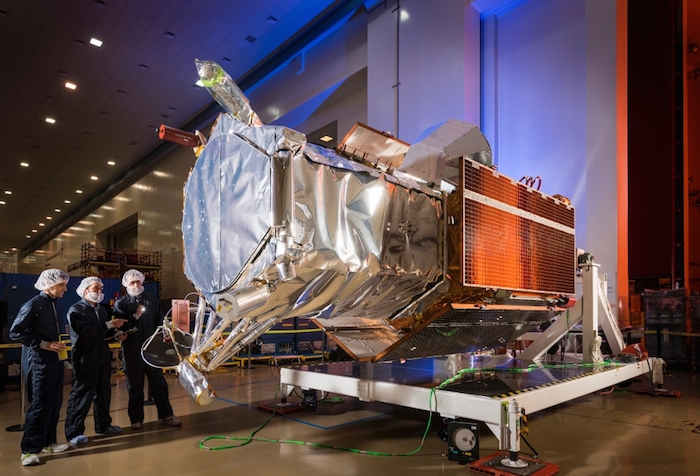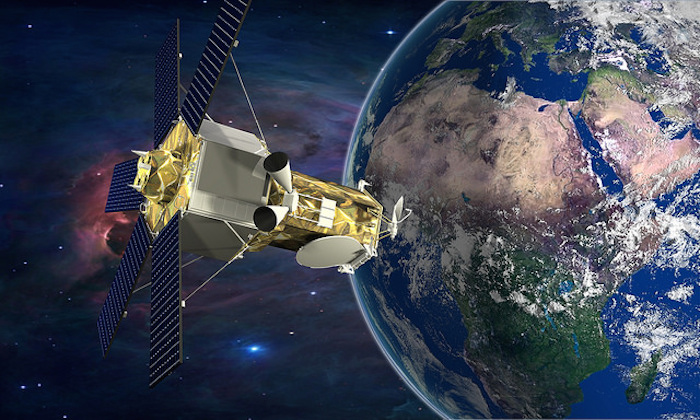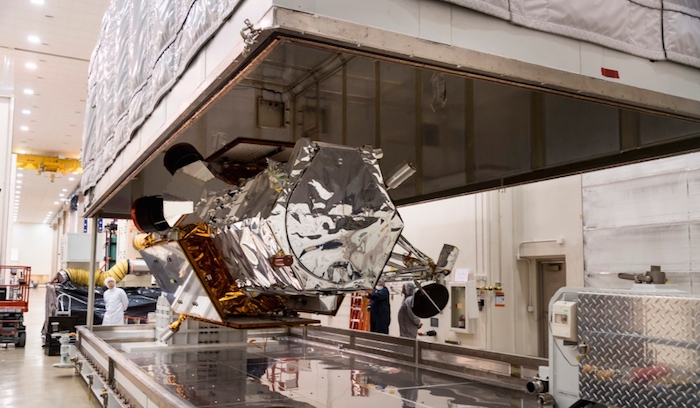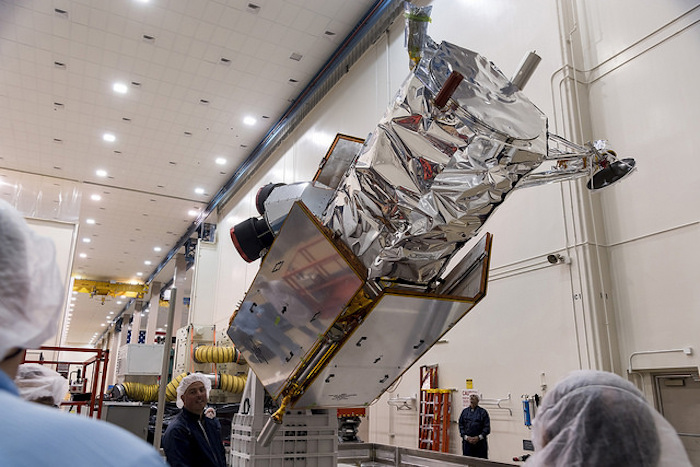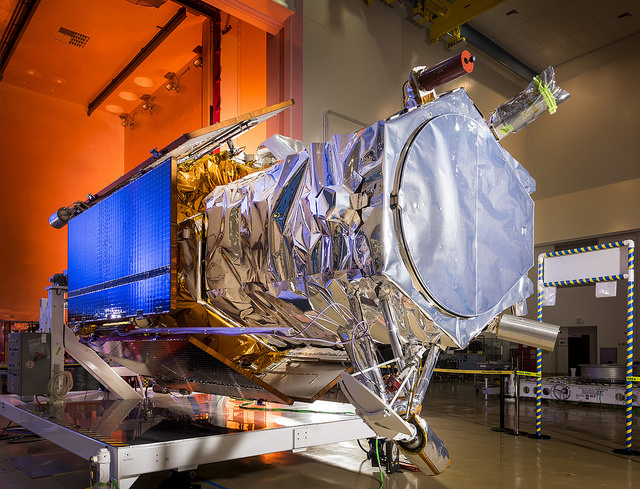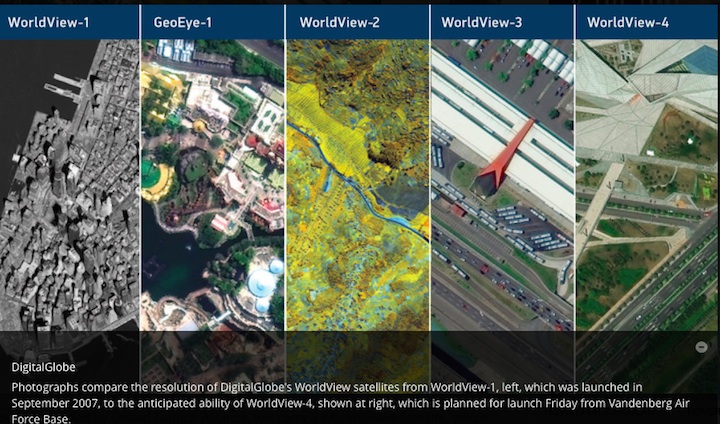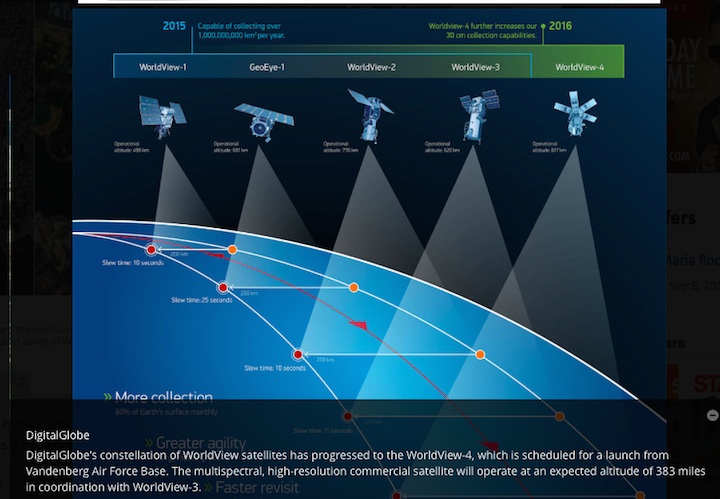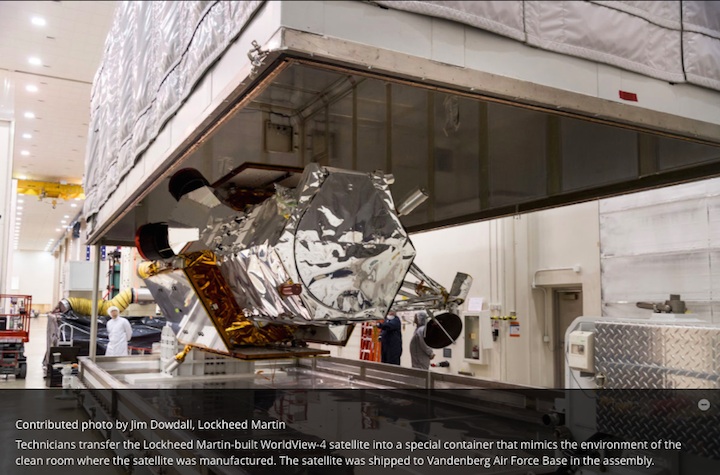Rocket/Payload:A United Launch Alliance Atlas V 401 configuration rocket will launch the WorldView-4 mission for DigitalGlobe. The Atlas V is provided by Lockheed Martin Commercial Launch Services.
Date/Site/Launch Time:Friday, Sept. 16, 2016, from Space Launch Complex (SLC)-3 at Vandenberg Air Force Base, California. The launch window is 11:30-11:44 a.m. PDT.
Live Broadcast: ULA’s live launch broadcast will begin at 11:05 a.m. PDT.
Mission Description: WorldView-4, a multispectral, high-resolution commercial imaging satellite owned and operated by DigitalGlobe, will help customers around the world see more of our changing planet. The satellite was built by Lockheed Martin Space Systems Company and will provide 31-centimeter panchromatic resolution and 1.24-meter multispectral resolution—the same resolution offered by the WorldView-3 satellite. This industry-leading resolution provides the sharpest view of vital details on the ground, to give customers confidence when making critical decisions.
Launch Notes: WorldView-4 marks ULA’s 9th launch of 2016 and 112th since the company was founded in 2006. ULA also launched WorldView-3 on Atlas V in 2014.
Go Atlas! Go Centaur! Go WorldView-4!
Quelle: ULA
-
Update: 16.09.2016 / 18.45 MESZ
-
Start von Atlas-V mit DigitalGlobe’s WorldView-4 Earth Imaging Satelliten
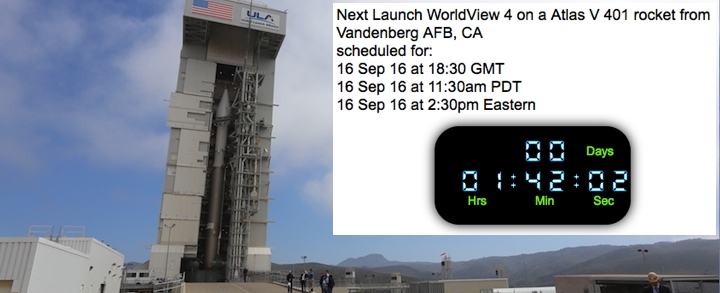
Atlas 5 Rocket on Track For Friday Blastoff from Vandenberg AFB
WorldView-4 mission will place Earth-imaging satellite into orbit


An Atlas 5 rocket and its commercial cargo — a satellite about the size of a Ford F-150 pickup truck — have cleared the final reviews to start counting down toward blastoff from Vandenberg Air Force Base late Friday morning.
The launch is set to occur between 11:30 and 11:44 a.m. from Space Launch Complex-3 East on South Base. Launch times are established to ensure the satellite gets placed into its proper place in space.
The 189-foot-tall rocket manufactured by United Launch Alliance will carry the WorldView-4 satellite, which was built by Lockheed Martin Corp. for DigitalGlobe, continuing a 17-year partnership for commercial Earth-imaging spacecraft.
“I think what we’re all going to witness tomorrow is all of that great experience coming to bear with a perfect launch and absolutely stunning images being delivered hours later,” Carl Marchetto, vice president and general manager of Lockheed Martin Commercial Space, said Thursday afternoon.
A launc-readiness review occurred Thursday morning to assess whether any issues remained to interfere with the launch, but the mission received the green light to proceed.
Weather isn’t expected to be a problem for the mission’s departure, with just a 20-percent likelihood conditions will force the team to try a different day.
The concern centers on launch visibility, officials said, adding that conditions improve to 10 percent if the mission slips to Saturday.t
The West Coast Atlas launch comes a week after a similar rocket launched a NASAmission from Florida.
The Vandenberg rocket will mark the 66th Atlas 5 liftoff, officials said. Most of those, or 32, involved the basic Atlas 5 rocket without any boosters strapped on to the lower portion.
“That really is the workhorse of our whole Atlas 5 family,” said Vern Thorp, ULA program manager.
Vandenberg officials said community members can view the launch from the Hawk’s Nest, the former mobile home park site on Highway 1, a half mile south of Vandenberg’s main gate.
Other popular viewing spots for South Base launches include the summit of Harris Grade Road, near the intersection of Moonglow and Stardust roads, and on Ocean Avenue west of Lompoc.
The Atlas 5 launch facility is visible on the horizon looking south of Ocean Avenue to the white gantry.
Quelle: Noozhawk
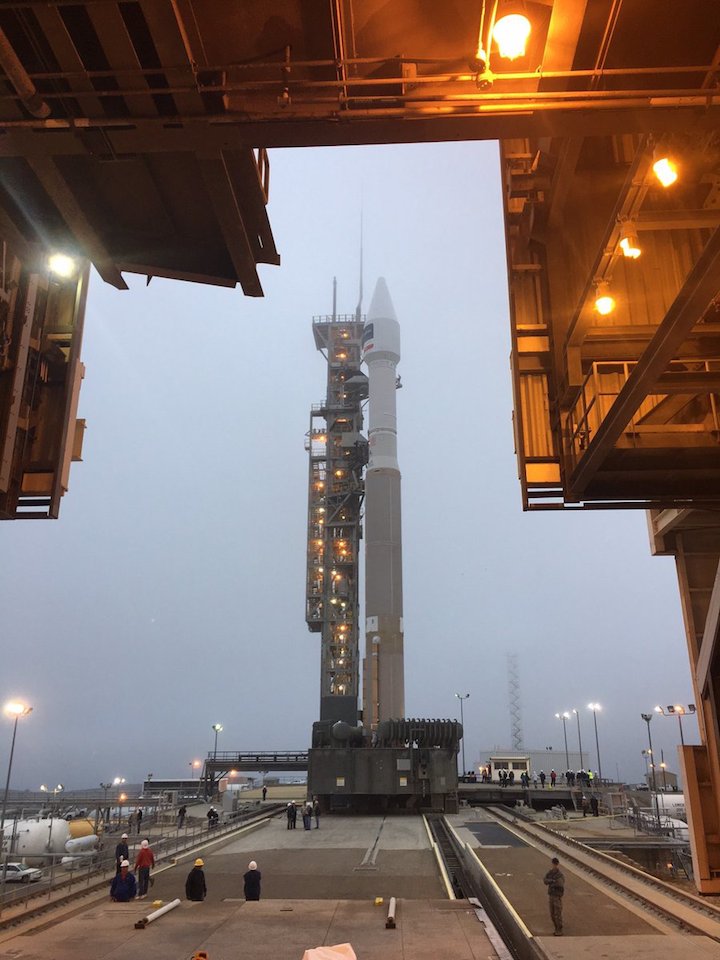
Foto: ULA
...
Update: 20.10 MESZ : Start ist verschoben!


...
#AtlasV WorldView-4 launch rescheduled for Sept. 17 pending resolution of the issue. Launch time is 11:30amPT; broadcast at 11:05amPT. #WV4
---
Update: 17.09.2016
-
UPDATE: Sept. 16, 2016, 5 p.m. PDT – The launch of a United Launch Alliance Atlas V carrying the WorldView-4 satellite is scheduled for Sunday, Sept. 18 to allow the team additional time to evaluate the cause of the ground leak anomaly experienced during propellant tanking. The launch window opens at 11:30 a.m. PDT.
Quelle: ULA
...
Atlas rocket launch delayed by pad hydrogen leak
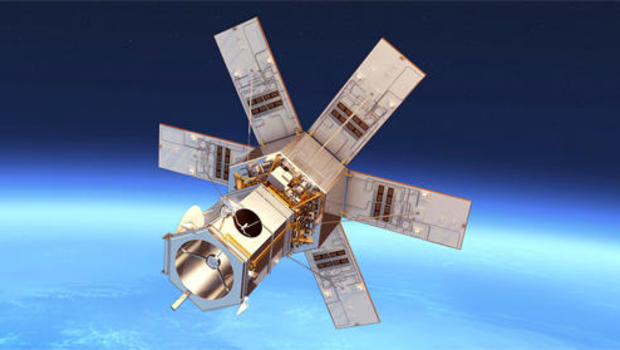
An artist’s impression of DigitalGlobe’s WorldView-4 commercial imaging satellite in orbit.
Launch of a United Launch Alliance Atlas 5 rocket carrying a DigitalGlobe high-resolution commercial surveillance satellite was scrubbed Friday because of a “very small” hydrogen leak in a ground system that caused an unusual “ice ball” to develop on an umbilical.
ULA rescheduled launch the WorldView-4 satellite from complex 3 at Vandenberg Air Force Base northwest of Los Angeles for Sunday at 2:30 p.m. EDT (GMT-4; 11:30 a.m. local time).
The countdown had just entered a planned 30-minute hold at the T-minus 4-minute mark Friday when ULA CEO Tory Bruno tweeted the launch would be delayed. The announcement followed the apparent resolution of an earlier problem that delayed the start of liquid hydrogen loading.
“Scrub,” Bruno tweeted. “Very small ground side LH2 (liquid hydrogen) leak. Forming an ice ball on the umbilical. Outside our history. Standing down attempt today to resolve.” He then added: “Always better to be on the ground, wishing you were in the air than the other way around.”
Quelle: CBS
-
Update: 18.09.2016
-
Atlas V WorldView-4 Mission Overview
Rocket/Payload:A United Launch Alliance Atlas V 401 configuration rocket will launch the WorldView-4 mission for DigitalGlobe. The Atlas V is provided by Lockheed Martin Commercial Launch Services.
Date/Site/Launch Time:Sunday, Sept. 18, 2016, from Space Launch Complex (SLC)-3 at Vandenberg Air Force Base, California. The launch window is 11:30-11:45 a.m. PDT.
Live Broadcast: ULA’s live launch broadcast will begin at 11:05 a.m. PDT.
Quelle: ULA
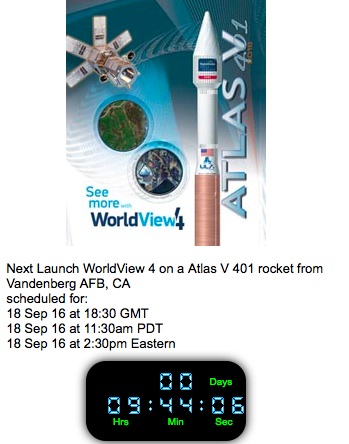
...
UPDATE: 19.15 MESZ
Date/Site/Launch Time: No earlier than Tuesday, Sept. 20, 2016, from Space Launch Complex (SLC)-3 at Vandenberg Air Force Base, California. The launch window is 11:30-11:45 a.m. PDT.
Live Broadcast: ULA’s live launch broadcast will begin at 11:05 a.m. PDT.
QUELLE: ULA
-
Update: 19.09.2016
-
Air Force Base Wildfire Postpones Hi-Res Satellite Launch
A wildfire burning at a central California Air Force base on Sunday forced the postponement of a satellite launch, officials said.
An Atlas 5 rocket was to carry a satellite known as WorldView-4 into orbit from Vandenberg Air Force Base. The satellite is designed to produce high-resolution images of Earth from space.
The fire burning in a remote canyon didn't immediately threaten the space launch complex, Col. Paul Nosek said on the base's Facebookpage. But he said the blaze required firefighters to be redeployed from standing by at the launch.
Nearly 800 firefighters were trying to corral the fire that was nearly 2 square miles in size.
The launch will be postponed until at least Sept. 26, according to United Launch Alliance, a joint venture by Lockheed Martin and Boeing Co.
The satellite is the latest in a series of imaging satellites built by Lockheed Martin. It is operated by Colorado-based DigitalGlobe, which provides images for government and private customers.
The satellite is designed to spot the make of a car from nearly 400 miles (643.71 kilometers) above Earth.
Quelle: abc-News
-
Update: Wildfire on Vandenberg Air Force Base burns over 2,000 acres
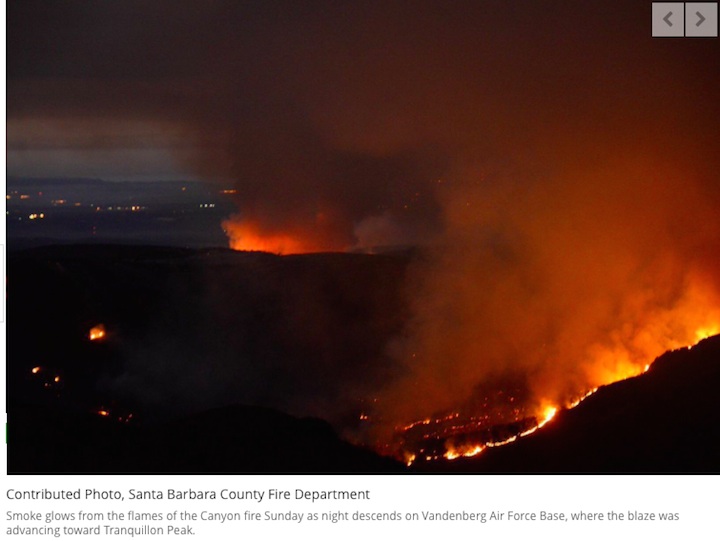
A wildfire that broke out Saturday evening at Vandenberg Air Force Base has scorched more than 2,200 acres as of Sunday evening.
Firefighters from Vandenberg Air Force Base, assisted by crews from Santa Barbara County Fire Department, Cal Fire and the U.S. Forest Service, are battling the Canyon fire on the South Base.
More than 250 firefighters are working to control the blaze that is still zero percent contained, fire officials said.
Engine crews are attacking spot fires directly, and Vandenberg and Santa Barbara County bulldozers are cutting new fire breaks, a base spokesman said.
Air tankers from Santa Maria Public and Paso Robles airports made “aggressive” fire retardant drops until darkness fell.
Vandenberg civil engineers are also working to restore power that was lost when the fire damaged power lines.
An evacuation warning was issued for about 50 homes in the Miguelito Canyon area, but the threat to that area was "minimal" as of 5:30 p.m., said Capt. Mike Zaniboni of the County Fire Department.
The fire broke out about 5:20 p.m. Saturday near Arguello and Santa Ynez Ridge roads and spread rapidly through heavy fuel, scorching 50 acres by 11 p.m., a County Fire spokesman said.
By 11 a.m. Sunday, it had grown to 500 acres, and by early afternoon it exceeded 1,200 acres.
Wayne Seda, incident commander from the Vandenberg Air Force Base Fire Department, said there is no estimated containment date, and the cause of the fire is undetermined.
Zaniboni said fire officials have requested additional help to fight the fire.
Until further notice, only mission-essential personnel, as designated by their commanders, will be granted access to South Base, the spokesman said.
Mission-essential personnel who work north of Mesa Road in the South Base area should use the South Base gate to enter the base, while mission-essential personnel who work at facilities along Coast Road should enter through the Coast Gate.
All others should contact their supervisory chain for reporting instructions, the spokesman said.
There are no restrictions on North Base activities, and personnel working in that area should report for duty using normal procedures.
Zaniboni said the fire is burning north to northwest toward two launch pads — Space Launch Complex-4, the SpaceX launch site, and SLC-3, where base officials scrubbed Sunday’s launch of an Atlas 5 rocket carrying the WorldView 4 satellite.
Although the fire did not pose an immediate threat to SLC-3 at the time, Col. Paul Nosek said it required the base to redeploy firefighters from stand-by at the launch site.
Air Force Lt. William Collette said no new date has been set for launching the WorldView 4 satellite, but United Launch Alliance officials said the launch will be postponed until at least Sept. 26.
WorldView 4 is the latest in a series of imaging satellites built by Lockheed Martin and designed to produce high-resolution images of Earth.
Officials said the satellite will be able to spot the make of a car from nearly 400 miles above Earth.
This story will be updated as soon as additional information becomes available.
Quelle: LOMPOC RECORD
-
Update: 11.10.2016
.
Launch of Atlas V Rocket Won’t Occur Until Late October or Early November
Liftoff from Vandenberg Air Force Base has been delayed due to Canyon Fire-related repairs


DigitalGlobe announced the launch status Monday morning, days after Vandenberg officials revealed they were bringing in additional crews to help with the aftermath of the Canyon Fire which charred more than 12,500 acres last month.
A faulty valve postponed the departure of the United Launch Alliance rocket’s departure Sept. 16, with plans to try again Sept. 18.
However, the Canyon Fire sparked on South Base, foiling the second attempt and leaving the rocket grounded indefinitely.
DigitalGlobe’s announcement says the launch has been “delayed due to ongoing efforts to restore and test infrastructure at Vandenberg Air Force Base following last month’s wildfires.
“DigitalGlobe is working closely with the U.S. Air Force and United Launch Alliance to identify a new launch date, targeting late October or early November,” the statement said.
“The WorldView-4 satellite is safe and secure atop its Atlas V launch vehicle. The company continues to expect WorldView-4 to begin generating revenue in the first half of 2017.”
Last week, after ignoring requests for information and giving no updates regarding efforts to restore launch support equipment damaged by the fire, Vandenberg officials admitted they had requested additional crews to help with repairs.
Members of the 85th Engineering & Installation Squadron from Keesler AFB, Mississippi were summoned to help Vandenberg crews with what base officials admitted involved “a large amount of work to be accomplished.”
WorldView-4 is the latest in a series of commercial high-resolution satellites providing data to customers in defense and intelligence, public safety, civil agencies, map making and analysis, environmental monitoring, oil and gas exploration, infrastructure management, navigation technology, and providers of location-based services.
Utilizing a routine rideshare program, Atlas also will carry a seven CubeSats sponsored by the National Reconnaissance Office and involving Cal Poly and Tyvak Nano-Satellite Systems Inc.
The CubeSats are part of an unclassified technology demonstration program.
Quelle: NOOZHAWK
-
Update: 26.10.2016
.
Atlas V Rocket Gets New Liftoff Date at Vandenberg Air Force Base
Mission to place commercial Earth-imaging satellite into orbit was delayed by last month's 12,500-acre Canyon Fire


Liftoff from Space Launch Complex-3 on South Base is planned between 10:30 to 10:46 a.m., making a seven-week delay for the mission.
Launch time is an hour earlier that previous attempts due to the end of Daylight Saving Time, and the fact clocks will fall back an hour the same day.
A rocket's departure time is based upon where the satellite needs to be placed in space.
The launch has been in limbo since Sept. 18, hours after a fire erupted on South Base.
Before being extinguished, the fire charred more than 12,500 acres, damaging multiple power poles and communication cables.
An initial countdown attempt on Sept. 16 was canceled approximately 30 minutes before blastoff due to a faulty valve.
During the lengthy delay, the WorldView-4 spacecraft, which was built by Lockheed Martin Corp., has remained perched atop the Atlas rocket at SLC-3, officials said.
DigitalGlobe representatives said they expected WorldView-4 to generate revenue in early 2017.
The rocket's primary passenger, a commercial Earth-imaging satellite, will continue adding to the firm’s library used by government, private and international customers once it reaches orbit.
Since the fire started, DigitalGlobe has been using sibling satellites, including WorldView-3, which launched from the site two years ago to capture images of South Base.
Those images have been provided to response teams on the ground, and reveal the fire was 2.5 kilometers, or 1.5 miles, from the launch pad, officials said.
The WorldView-3 satellite boasts a short-wave infrared sensor, which is able to pierce through smoke and see where fires are burning on the ground.
In addition to WorldView-4, the rocket will carry several small spacecraft called CubeSats for the National Reconnaissance Office under an unclassified technology demonstration program.
Quelle: Noozhawk
-

